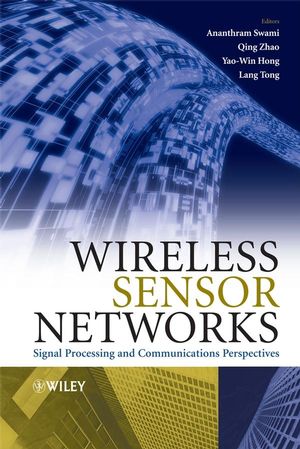Wireless Sensor Networks: Signal Processing and Communications PerspectivesISBN: 978-0-470-03557-3
Hardcover
416 pages
November 2007
 |
||||||
1. Introduction.
Part I. Fundamental Properties and Limits.
2. Information-theoretic Bounds on Sensor Network Performance (Michael Gastpar).
2.1 Introduction.
2.2 Sensor Network Models.
2.3 Digital Architectures.
2.4 The Price of Digital Architectures.
2.5 Bounds on General Architectures.
2.6 Concluding Remarks and Some Interesting Questions.
Bibliography.
3 In-Network Information Processing in Wireless Sensor Networks (Arvind Giridhar and P. R. Kumar).
3.1 Introduction.
3.2 Communication Complexity Model.
3.3 Computing Functions Over Wireless Networks: Spatial Reuse and Block Computation .
3.4 Wireless Networks with Noisy Communications: Reliable Computation in a Collocated Broadcast Network.
3.5 Towards an Information Theoretic Formulation.
3.6 Conclusion.
Bibliography.
4 The Sensing Capacity of Sensor Networks (Rohit Negi, Yaron Rachlin, and Pradeep Khosla).
4.1 Introduction.
4.2 Sensing Capacity of Sensor Networks.
4.3 Extensions to other Sensor Network Models.
4.4 Discussion and Open Problems.
Bibliography.
5. Law of Sensor Network Lifetime and Its Applications (Yunxia Chen and Qing Zhao).
5.1 Introduction.
5.2 Law of Network Lifetime and General Design Principle.
5.3 Fundamental Performance Limit: A Stochastic Shortest Path Framework.
5.4 Distributed Asymptotically Optimal Transmission Scheduling.
5.5 A Brief Overview of Network Lifetime Analysis.
5.6 Conclusion.
Bibliography.
Part II. Signal Processing for Sensor Networks.
6. Detection in Sensor Networks.
6.1 Centralized Detection.
6.2 The Classical Decentralized Detection Framework.
6.3 Decentralized Detection in Wireless Sensor Networks.
6.4 Wireless Sensor Networks.
6.5 New Paradigms.
6.6 Extensions and Generalizations.
6.7 Discussion and Concluding Remarks.
Bibliography.
7. Distributed Estimation Under Bandwidth and Energy Constraints (Alejandro Ribeiro, Ioannis D. Schizas, Jin-Jun Xiao, Georgios B. Giannakis and Zhi-Quan Luo).
7.1 Distributed Quantization-Estimation.
7.2 Maximum Likelihood Estimation.
7.3 Unknown noise pdf.
7.4 Estimation of Vector parameters.
7.5 Maximum a Posteriori Probability Estimation.
7.6 Dimensionality Reduction for Distributed Estimation.
7.7 Distortion-RateAnalysis.
7.8 Conclusion.
7.9 Further Reading.
Bibliography.
8. Distributed Learning in Wireless Sensor Networks (Joel B. Predd, Sanjeev R. Kulkarni, and H. Vincent Poor).
8.1 Introduction.
8.2 Classical Learning.
8.3 Distributed Learningin Wireless Sensor Networks.
8.4 Distributed Learningin WSNs with a Fusion Center.
8.5 Distributed Learningin Ad-hocWSNs with In-network Processing.
8.6 Conclusion.
Bibliography.
9. Graphical Models and Fusion in Sensor Networks (M¨ujdat C¸ etin, Lei Chen, John W. Fisher III, Alexander T. Ihler, O. Patrick Kreidl, Randolph L. Moses, Martin J. Wainwright, Jason L. Williams, and Alan S. Willsky).
9.1 Introduction.
9.2 Graphical Models.
9.3 From Sensor Network Fusion to Graphical Models.
9.4 Message Censoring, Approximation,and Impacton Fusion.
9.5 The Effects of Message Approximation .
9.6 Optimizing theUse of Constrained Resources in Network Fusion.
9.7 Conclusion.
Bibliography.
Part III. Communications, Networking and Cross-Layered Designs.
10. Randomized Cooperative Transmission in Large-Scale Sensor Networks (Birsen Sirkeci-Mergen and Anna Scaglione).
10.1 Introduction.
10.2 Transmit cooperation in sensor networks.
10.3 Randomized distributed cooperative schemes.
10.4 Performance of Randomized Cooperative Codes.
10.5 Analysis of Cooperative Large-scale Networks utilizing Randomized Cooperative Codes.
10.6 Conclusion.
10.7 Appendix.
Bibliography.
11. Application Dependent Shortest Path Routing in Ad-Hoc Sensor Networks (Saswat Misra, Lang Tong, and Anthony Ephremides).
11.1 Introduction.
11.2 Fundamental SPR.
11.3 SPR for MobileWireless Networks.
11.4 SPRf or Ad-Hoc Sensor Networks.
11.5 Conclusion.
11.6 A Short Review of Basic Graph Theory.
Bibliography.
12. Data-Centric and CooperativeMAC Protocols for Sensor Networks (Yao-Win Hong and Pramod K. Varshney).
12.1 Introduction.
12.2 Traditional Medium Access Control Protocols: Random Access and Deterministic Scheduling.
12.3 Energy Efficient MAC Protocols for Sensor Networks.
12.4 Data-Centric MAC Protocols for Sensor Networks.
12.5 Cooperative MAC Protocol for Independent Sources.
12.6 Cooperative MAC Protocol for Correlated Sensors.
12.7 DiscussionandFutureResearchDirections.
Bibliography.
13. Game Theoretic Activation and Transmission Scheduling in Unattended Ground Sensor Networks: A Correlated Equilibrium Approach (Vikram Krishnamurthy, Michael Maskery, and Minh Hanh Ngo).
13.1 Introduction.
13.2 Unattended Ground Sensor Network: Capabilities and Objectives.
13.3 Sensor Activation as the Correlated Equilibrium of a Noncooperative Game.
13.4 Energy Efficient Transmission Scheduling in UGSN - A Markov Decision Process Approach.
13.5 Numerical Results.
13.6 Discussion and Extensions .
13.7 Appendix.
Bibliography.
Index.



